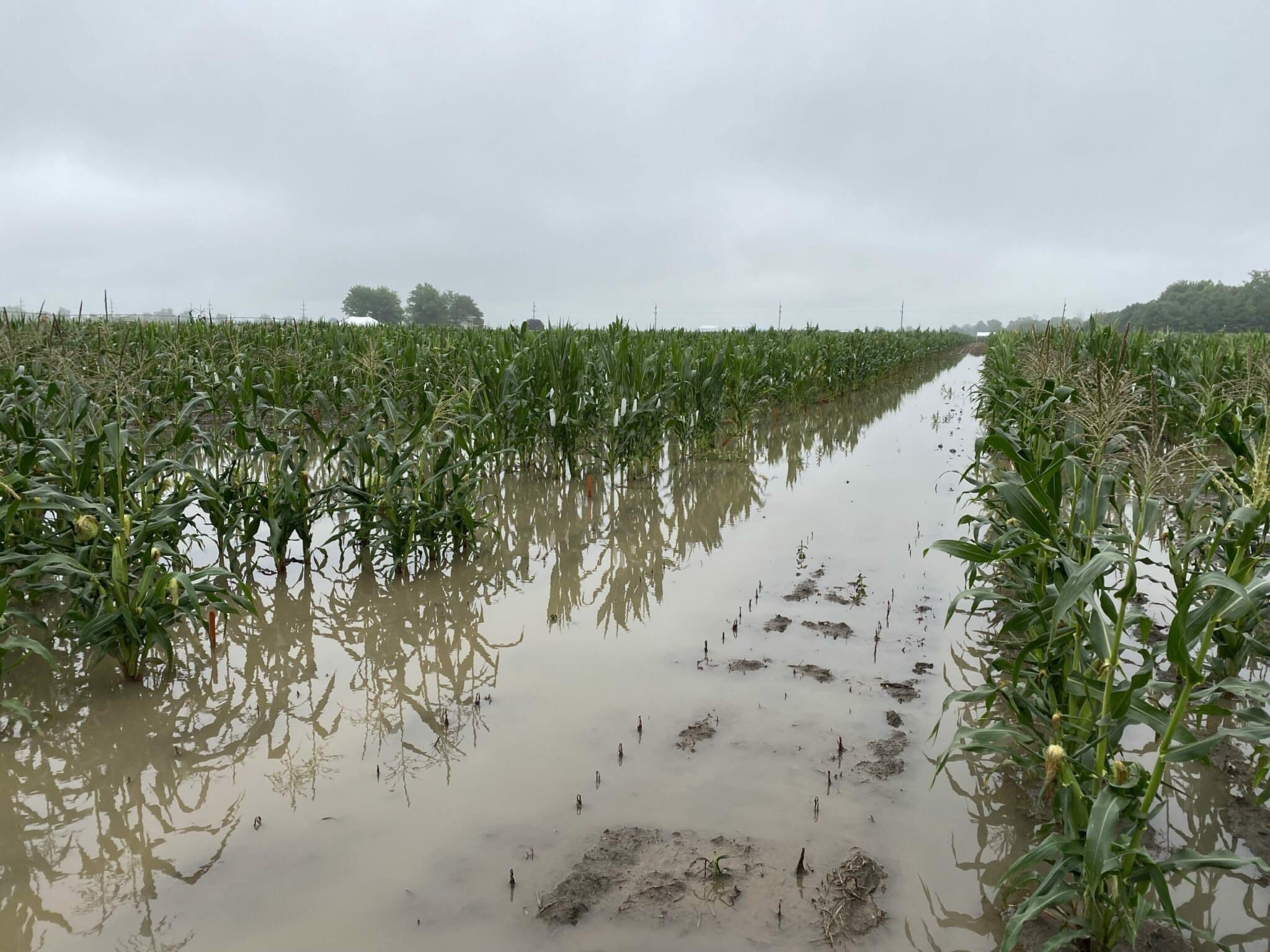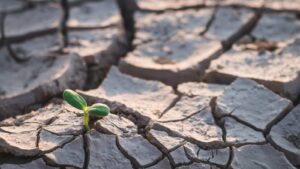Today’s breeders address corn concerns in the face of climate change.
From drought to flood, and back to drought again the next year, today’s farmers face increasingly extreme swings in weather as a result of global climate change. Seed breeders are tasked with using data in new ways to protect yields.
“As a breeder, it’s my responsibility to think 10 or 15 years in the future, so that farmers have the products and the tools available to them to meet the demands that are going to be there at that time,” says Stephen Swarm, corn breeder for Beck’s Hybrids.
Swarm is a specialist in stress breeding; his efforts are focused on Indiana, Ohio, Kentucky, Tennessee and Southern Illinois, but the lessons he’s learned can be applied far and wide.
Predicting the Future
While farmers understand that climate is different than what it was 20 years ago, making sense of the rapidly changing weather trends can be a challenge.
“Growers aren’t necessarily thinking about what they will need 10 years from now. They are thinking about how to get yields this season,” says Will Kletter, head of customer success at ClimateAi.
However, because seeds must be developed years in advance, it’s crucial for breeders and developers to have an idea of what climate conditions will be present in the future.
And for that, they need numbers. But maybe not the numbers that come to mind at first.
Kletter says historical averages are no longer as helpful in determining future seed needs. It’s not enough to just know that an area is getting hotter, or drier.
“We don’t talk about the average temperature; we talk about the number of days above 90 degrees Fahrenheit in July in the 2030s. So, when you might experience a heat stress during flowering, for example,” Kletter explains.
ClimateAi uses analytics and machine learning to help answer these specific questions to inform their clients’ breeding and market strategies.
Conquer by Diving
The first step to actionable opportunities is to divide growing regions into zones with similar expected climate shifts, looking specifically at what risks need to be evaluated.
“And by marrying these onto those traits, we’re able to say, for example, that a certain number of acres will experience extreme heat. And without a heat tolerant variety, you stand to lose ‘x’ million dollars of sales. Or, with that variety, you could gain ‘x’ million dollars of sales by being the most prepared for this new market,” Kletter says.

Then, once they have those estimates, the next step is to find a place where those conditions are the current reality, not the future expectation.
“If that’s the market 20 years from now, where can I test today? It’s almost like a Google search for climate to find a place that looks like today, what Indiana will look like 20 years from now, so that I can cite my trial locations in a place that is representative of what my customers will experience when I actually get to market,” Kletter says.
Big Picture, Bigger Impacts
It’s important to keep a broad perspective when considering climate change.
“We expect warmer and drier summers, which is kind of what you think of at first with global warming, but that’s not really the full picture. With climate change, we’re also seeing earlier and heavier rains in the spring. And just in general, more extreme weather events that we’re having to deal with,” Swarm says.
He cites the drought in 2012 with severe conditions across most of the U.S., but also the floods in 2019, which delayed planting to late May, or early June in many parts of the country.
“These are very different events, but both are very harmful for the overall crop,” Swarm says.
For Kletter, it comes down to protecting the future of the industry in a proactive, not just reactive way. They look at what is going to happen in the areas growers are currently producing, but also identify new areas that growers should produce in or sell into in the future.
“Climate change is disruptive, but it will also create new suitable climates for our crops. And we need to know what those are so we can move ahead and move ahead of our competitors,” he says.
Tests for Success
Swarm likes to think about this in terms of yield stability. “By definition, for yield stability, you have to be able to cope with a wide variety of stresses, including drought, and changes in weather patterns,” Swarm says.
His goal is to create “workhouse hybrids, with a punch,” that produce acceptable results in high stress, but with the potential to see high yields when given the opportunity to perform.
“You want it to work in all different kinds of growing conditions,” he says. Often, that means yield protection agronomics such as strong roots and stocks, shorter plant height, disease resistance, and uniform emergence.
“As breeders, we need to target traits that are important now, but also with changing climates and how those traits are going to be more important or less important for specific areas,” Swarm says.
For example, if farmers are dealing with heavier storms, such as in western states, they’re probably going to have a higher emphasis on reducing plant height. With heavier rains, strong emergence is key. When looking at more drought conditions, an earlier flowering time could be a higher importance.
Swarm says he breeds for this yield stability by testing in a range of environments.
“My testing zones are not only in high potential, but we’re also looking at medium potential soils and then late stage testing in low potential soils as well,” he says.
Moreover, selecting hybrids is not solely based off of overall average yield.
“I’m also looking at consistency for proof of performance. So even though on average, it might win the trial. If it’s not consistently in the top section of the trials, then maybe that one does not move forward, as you would expect,” he explains.
More Than Meets the Eye
One of the most concerning aspects of climate change is that climate change doesn’t just affect the weather. Kletter explained that when one thing changes, such as more rainfall in a specific area, there are trickle-down shifts to watch for.
“Our agronomic system is in a very fine balance,” he says.
So, more extreme rains don’t just mean flooding and loss of plots, they also mean changes to the soil.

“Heavier rains mean more nitrogen nutrient loss. It’s becoming more important to side dress and have later season application of nutrients,” Swarm says.
It’s also important to think about how climate affects pests and disease.
“Warmer winters may have a potential for more overwintering pests,” Swarm says.
Diseases also evolve over time as the climate changes.
Tar spot, for example, is a new evolving disease that breeders are watching.
“We don’t know how that’s going to play out economically. Is it going to be a big disease that we’re going to have to breed for, or is it going to fizzle out? We won’t know until in the future,” Swarm says.
Swarm says one other change is that farmers are starting to grow fuller season hybrids further north.
“As the growing season lengthens, these farmers are going to take advantage of it,” he says. He gave the example that something that may have been targeted for Southern Indiana, could start being grown in Central Indiana.
Genomic Prediction
Swarm says Beck’s Hybrids has had great success with genomic prediction in breeding. With this process, breeders only test the hybrids that are most likely to succeed, based on predictions, instead of wasting resources on hybrids that have no hope of succeeding.
“We’re predicting millions of hybrid combinations, and we’re only taking the very best that has the highest probability for success and testing that into the field,” Swarm says.
This increases the genetic gain.
So far, breeders have been able to accurately predict performance of hybrids in specific environments where previous data had already been collected, but now they are working to expand that to predicting performance in new environments.
“While you can still go to the same field in those past environments, the weather is going to be different. So being able to predict into new environments becomes key,” Swarm says.
The hope is to use this as a product placement tool for breeders.
“Just because I develop an inbred for my program doesn’t mean it’s going to be best adapted to Indiana and Ohio. It may have a better fit in, say, Iowa. So, if we can identify where to place inbreds and hybrids, then we can test them in their best environments,” Swarm says.
All of these predictions rely on data collection.
“We are collecting massive amounts of data with drones, weather stations and soil probes,” Swarm says.
There have been a lot of advances, but it’s still a work in progress.
“The trick here is identifying what is actually the most key to making the predictions and how to use that in a model, so this is something that we are working on,” Swarm says.
The Future Starts Now
Even with machine learning, and a heavy reliance on data collection and application, it’s not going to be an easy road.
“Something that makes things difficult is that these weather events are not predictable and uniform. For example, 2012 was a drought across the Corn Belt, but since then, for Indiana at least, we haven’t really had strong drought conditions,” Swarm says.
So, breeders can’t always test in a consistent environment.
“But when those conditions arise, you want to be prepared to handle those,” Swarm says.
He is still optimistic, however.
“The silver lining with these weather events is that you get a chance to see what works in a hybrid. When we have strong winds, you find out what’s got weak roots or weak stalks and what’s going to break,” he says.
Moreover, these extreme weather situations are likely to continue to increase in frequency. While an overall shift in overall climate might look like the world getting warmer by one degree two degrees, Kletter says that’s just the average. In some places, the temperatures are rising much faster.
But also, as the averages move, the chance of an extreme event increases exponentially.
“A one degree increase in the average temperature can mean a two times increase in the chances of an extreme event,” Kletter says.
For example, in the U.S., it might not be the overall slight rise in temperature average that’s causing a problem, but rather the increasing number of extreme heat days during the summer months.
“We often think of climate change in terms of longer-term impacts, but the decisions we need to make to set ourselves up for future success have to happen today,” Kletter says.
Want to Read More? Check Out…
Staying Competitive in a Soybean Market – A Seed World Strategy Webinar & Podcast












